One of the recent issues arising with regard to leadlight panels are premade doors containing leadlight panels or leadlight look alikes. This recent leadlight of similar design containing central bevel cluster and bevel circles that I completed to replace a rather thin and flimsy leadlight made from very thin glass which had been in a door purchased as a new replacement front door .While looking similar to the real thing the artificial leadlight is very different and is very hard to pick this difference!.
I have added a pink border on this one at request of the client, as most of the panels usually are uncoloured glass and either rectangular or oval containing bevel clusters or bevels. With this particular door, the panel had been stapled into the door and both the door and the shape of panel were not at all symmetrical which made the task even more difficult being a symmetrical design!! . The trim was compressed cardboard. I have had several requests from customers who have ended up with a broken panel as a result of a slight bang on the leadlight with keys or an object, or the door shutting a little too hard. I altered this leadlight to ensure the background glass contained more pieces( eight instead of six ) so as to be in keeping with safety standards. The last thing one would want is for a child to be able to break the glass on contact and suffer an injury! Also the security is an issue in being so flimsy as to be able to be broken and piece removed allowing access to the lock. Authentic lead lights are quite strong and in being made the original way, and puttied rather glued in, whereas some artificial leadlights are nowhere near as durable. It seems these doors with premade "leadlight panels" are readily available on the market, and for those wanting a leadlight panel is not quite the " real thing". If buying such a door it pays to ask about the glass panels!
TESTIMONIALS
*Glazier came round today - see attached for the (fantastic) results. I'm delighted with it - once again, thank you so much! Comment by owner James.*Many thanks for your hard work. The leadlighting is a great addition to the overall impression of the house.
Prue -Hunter Valley Jan 2009
* Nola said " Oh Yes, one very thrilled recipient here! Jan 26 2008
* Prue & Dennis: Hunter Valley : Dennis and I are thrilled with the work you have done on the leadlights. It has made our home come alive !!! Your expertise has restored the entrance hall and the front bedroom to how I imagine they must have looked when the house was built in the 1890s - albeit, with a different design. Many people have been "blown away" with the effect of your excellent work and are especially interested to know that you created it all, long-distance - from Lockhart in the Riverina - via telephone calls, emails and our very careful measurements ! Thank you for the time taken, on our behalf, to research the best methods of transporting our beautiful porthole leadlight to the Hunter Valley . Thank you too, to Les who assisted you by making up the sturdy crate in which the leadlight was transported. You are both very talented people and I intend, in a few months time, to commission Les to paint a picture of our restored house. We will be in touch again to have the remaining transom designed for the back door, when work has been completed in the kitchen. Many thanks for your delightful friendliness, customer-support and speedy completion of our superb new addition to our "work-in-progress".Prue and Dennis
* Monday, October 01, 2007 Anne Muir said...
Hi, I am the person who commissioned this beautiful hexagonal window from RL. I was after a dove of peace and although I had something in mind, I could not really describe what I wanted . RL came back with a few ideas and after a few changes we ended up with the above. I am absolutely thrilled with it and can't wait to see it installed in our new home which is currently under construction. I will send a picture to RL once we are in the house. I am extremely happy with RLs work and all her help with colours and textures etc.. I would definitely recommend Riverina Leadlight to anyone interested in adding something different and beautiful to their home.
Nola said...
* Love the new work, as I'm sure the new owners will too. It must be frustrating to encounter other people's poor workmanship. I know that fixing things done wrong first time around is not easy or pleasant work! Or cheap, for the owner!
Maryann 'n Steve said...
Thanks to RL we are now the very proud owners of some absolutely gorgeous waterbirds. We cannot express how happy we are with every aspect of our interactions with RL , from the initial consultation, through the whole design and consultation process, to viewing the work in progress and now the finished product. This is a very special addition to our backyard (yes, we are a little eccentric...most people put their leadlight in the house!). Riverina Leadlight have our recommendation to anyone looking for something different, created by someone who listens to your ideas, and produces a truly unique masterpiece. We are ecstatic!!Thanks Glen.....we will be back!
What is leadlight?
Leadlight consists of panels made up of small pieces of clear or coloured glass fitted together and separated by lead stripping .
How is a leadlight made?
1. A design is created anda pattern drawn.
2. The glass pieces are cut to shape from the pattern
3 The pieces are fitted together like a jigsaw with the pieces separated by strips of H shaped lead to complete the design .
4 The joins are soldered to form a solid panel the correct size to fit a frame, window or door space.
(External or large internal panels such as doors and windows are reinforced for added strength and puttied and polished after construction to protect against the weather.)
5. The leadlight is puttied, cleaned and polished to blacken the lead
6 The leadlight is installed just as a pane of glass would be installed in a window frame.
The majority of our designs are unique and made to specification and we are able to create designs to suit a range of situations whether modern style, or Edwardian and Victorian.
Copperfoil products, also available, are not leadlight as they are not made using the same process, and therefore have limited applications such as lamps, small mirrors and light catchers.
Where leadlight be displayed in my home?
Leadlight can be fitted into front door surrounds e.g. sidelights, front doors, internal doors as well as windows.
Modern designs can be created to suit 21st Century homes and should a permanent fixture not be possible, free hanging pieces are available.
In older homes, transoms above doors were often leadlighted allowing both light and air to pass between rooms. These panels were often hinged to allow warm air to flow between the rooms or to the outside on hot days, allowing cooler air to take its place. Fan shaped leadlights or " fanlights" also added colour and light to internal hallways.
A timber surround is preferred to allow flexibility of movement and to minimise expansion. Leadlight can be installed anywhere either internally or externally, however external panels require weather proofing and in some cased reinforcement. Porthole windows are a popular addition to some homes today and leadlights provide privacy as an alternative to plain glass or block excessive glare from the sun.
An addition to any bathroom or hallway can be a leadlight mirror with decorative design, framed or unframed to be hung or afixed to the wall. Cabinet and cupboard doors are another alternative in wall units or free standing cabinets. Brightly coloured mirror glass can be used to create artworks where backlighting is minimal, however lighting from behind can be fitted if desired.
Would I be able to make or repair a leadlight?
Many people undertake leadlight courses for various reasons , some with a view to learning a new skill, to create lamps and hangings, or make panels for their homes. It is important, however, to keep in focus as with any project, just what is involved in creating a piece, prior to commencement as this can often allay anguish and also unnecessary expense. While creating a light catcher can be a relatively simple and straight forward process, building a door panel or window pane can be a very different issue . Constructing a toolbox is largely different from building a house or a new kitchen and leadlight is a complex task!
I have had many people ask if I conduct classes as they wish to create a window or sidelight for their home with view to it being a cost saver. However, a half a dozen woodwork classes does not a back deck build and with door and window panels consideration must be given to a range of factors such as durability and stability, and waterproofing.
Unfortunately due to the issues of liability & safety, coupled with work space and cost factors I do not conduct leadlight classes however they are available through incorporated institutions such as TAFE.
Developing the basics of cutting and fitting pieces of glass together to create a panel or lamp the correct size takes some time and before committing funds to tools and materials it is wise, if considering DYI a cheaper option, to set realistic goals, to consider the reasons for embarking on a course and to research what is required to gain the desired result. After all, the last thing anyone would want is to considerable money spent on materials, course and tools to create a window only to find it sags and requires expert input to rectify the problem within a couple of years. ( Point in case being the case with a particular church window in the ACT designed and constructed all but a few years ago by someone claiming to be a leadlighter only to show signs of serious sagging and requiring attention. )
Leadlight courses include many facets ranging from craft like activities - copper foiling, lamp making, light catchers (which can be hung in front of windows )and smaller leadlight panels such as cabinets to trade based larger projects. It can require time and experience to reach the stage of knowledge of structures and construction techniques.
SO WHAT IS COPPERFOIL? Copperfoil is made by placing foil strips over the edge of the glass, piecing the glass design together by placing the pieces side by side and soldering over the entire foil strip. While it is light and suitable for lamps and smaller light catchers, it is far less flexible than leadlight as the H lead used in leadlight acts as a cushioning agent absorbing vibration during movement. ( e.g. caused by ground or air) Copperfoil panels are more rigid being separated by a paper thin strip of foil and consequently will often crack under the stress of movement and vibration-constant opening and closing - internal pressure created by air movement or ground movement resulting from traffic, climate and other factors.
It is important to consider the building standards regarding different situations of panels, depending on height, size, and placement whether in a bathroom, a wall, on a landing; internal or external and those not engaged in professional leadlight trade should check structural issues prior to embarking on a major project as some panels require reinforcement and support given the weight and location of the panel. Leadlight is very heavy and given a square metre of glass minus lead can weigh up to 7 kilos, a leadlight panel of same size can weight considerably more.
Leadlight is definitely should be viewed a trade rather than a hobby and professional leadlighters contacted regarding products and courses to ensure theyare experienced and /or a registered business.
Can leadlight be fitted into aluminium windows?
Leadlight is able to be fitted to most windows, doors and timber frames on external windows or internal spaces. The building process for the leadlight is very precise given a different lead is used. If building a new home, it is possible to contact the window company or your builder to let them know your plans for leadlight, so the company can include it in their plans rather than making changes after the house is finished construction. This information can be shared with a leadlighter of your choice and if need be they can communicate with your window maker or builder.
Timber windows do lend themselves far better to leadlight, and while the remaining windows in a home may be aluminium, it is possible to insert a timber frame in areas such as bathrooms to accommodate a leadlight.
How can I tell the condition of my leadlight?
HOW CAN I TELL IF MY LEADLIGHT IS WORTH FIXING OR NOT?
Leadlight if in good condition should be quite solid and strong. They can last many decades, even centuries depending on the degree of care. Sometimes if subjected to movement or impact, the leadlight may become loose and the lead may not support the glass sufficiently if the joints are poorly soldered. Lead which has been exposed to chemicals can resulted in oxidation and glass can become sandblasted over time in dry and dusty areas or if in a smoky or smoggy area. If subjected to continual movement and not reinforced, depending on how the leadlight was made, solder joints can fracture, putty from under the lead break away and cracks appear in the glass. In some cases, if subjected to stress, glass can develop hairline fractures almost naked to the human eye until the leadlight is dismantled or removed. However a well made leadlight should last for many years.
More often than not the leadlight can be repaired or restored if the glass is cracked or broken however if the leadlight has been poorly made, has gaps between the glass and the lead, is sandblasted or is allowing dust, drafts or water through gaps and if there is no other matching leadlight it may be more cost efficient to have a quality leadlight replacement build to same , similar or new design.
To determine the condition, tap gently with the hand or fingers and press with the hand on the leadlight pane. If it flexes more than the usual small amount (leadlight is meant to flex a little in order to withstand movement and air pressure), or if it rattles then it is in need of repair.
Placing sticky tape or contact over the leadlight is not a good idea unless a temporary screen to dust or rain and in this event if necessary, some masking tape and a small piece of heavy duty plastic is a far better alternative temporary measure until the leadlight can be repaired.
Leadlight is usually quite tough and solid if in good condition and well made. Solder joints and lead should be free of fine cracks. Glass which has cracked ( sometimes hairline and almost invisible to the naked eye) or broken should be replaced as over time the leadlight may weaken and is more difficult to salvage. If the glass is generally in good condition the lead can be replaced and re soldered requiring a REBUILD or RESTORE. Pieces of broken glass can often be matched and or replaced which is a REPAIR.
Should gaps can appear between the lead and the glass, it may require a complete re-seating into the lead or glass recut as poor cutting can result in the glass not seating into the lead came neatly. Some leadlight I have repaired or restored have contained glass which has been very poorly or roughly cut creating gaps between the glass and lead.
WHAT CAN BE DONE IF LEADLIGHTS ARE IN NEED OF REPAIR AND I AM SITUATED IN AN ISOLATED AREA?
For those living in isolated country areas who have leadlight in need of repair, leadlight panels can be removed by removing beading or putty using a chisel or sharp object. Before removing- photograph and measure the opening. When removing, if the leadlight is lacking in strength it can be placed or taped / strapped onto a board . The leadlight can be packaged in wooden panelling and transported to us for repair. If less than metre in length, Australia Post provides good service for a reasonable rate. We can repair the leadlight and return it within a few days depending upon our workload, however we endeavour to carry out emergency repairs to panels as quickly as possible. It also necessary to provide an exact measurement of the space from which the leadlight was removed ( to the nearest Millimetre, plus a photo of the design in case of total collapse! Then a new design cam be created to suit the existing pieces and measurements.
In the interim, the window space can be filled temporarily with a board such as MDF cut to size by a carpenter or builder or owner if a handy person and leadlights are not overly difficult to install as they are in one piece similar to what a panel of glass would be ( and equivalent in size).
On reinserting panels, glaziers points can be used then some putty or a non corrosive silicon applied to the outside after installation and trim or strips of putty being reapplied if necessary.
Leadlights and stained glass panels are relatively simple to install and the panel is a solid one piece which can be placed in situ given it is built to fit the precise space with a couple of millimetres to allow for movement. The surrounding lead should NEVER have nails or tacks placed through it as this can cause the leadlight to twist in event of movement resulting in cracking and warping. Where leadlight is installed by clients or tradesmen, we are more than happy to provide assistance or advice to make the process and simple as possible and to ensure the leadlight will provide pleasure or enjoyment for many years to come.
For all enquiries
or for more information you can visit:
http://www.riverinaleadlight.com.au/
Repairs and Restorations
Authentic Leadlight, is able to be repaired- refer to photos of some restored and repaired. The extent of the damage and overall quality of the leadlight influences the work involved. However as mentioned above: Artificial leadlight which is either glued or made with a single piece of glass and a design printed onto the glass which is extremely thin is often able to be repaired or restored.
Leadlight panels, if old and subjected to movement or stresses over years may require re-puttying if the old cement has turned powdery and the leadlight rattles. Over time, some cements can deteriorate allowing moisture and air to pass between the glass and the lead. The putty falls away as a fine dust. Excessive stress or movement may cause fine cracks to appear in the lead, glass or solder joints. If the joints and lead are in good condition, the leadlight may just require re-cementing.
If the lead has deteriorated, the leadlight may be taken apart glass removed, cleaned and rebuilt with broken sections replaced with new glass and lead if required.
If the leadlight is in poor condition, there are no other matching pieces, does not have historical significance or has been poorly made, a new replacement may be a more financially viable option. By retaining the old design and closely matching colours and textures an almost identical leadlight can be created in keeping with the original design. Some pieces of unique glass from the original leadlight may also be retained and reused and background replaced, depending upon the quality of the leadlight. If pieces have been badly cut or fitted, they may need reformatting.

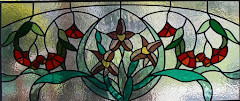












.jpg)













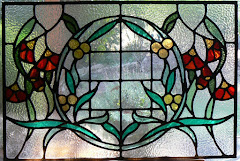




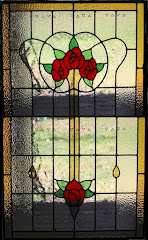


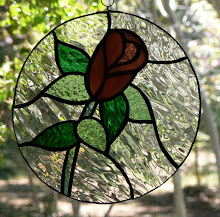












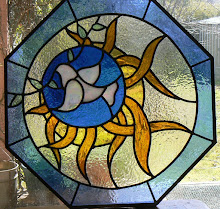





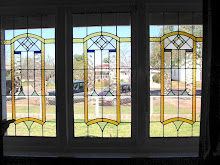






















No comments:
Post a Comment